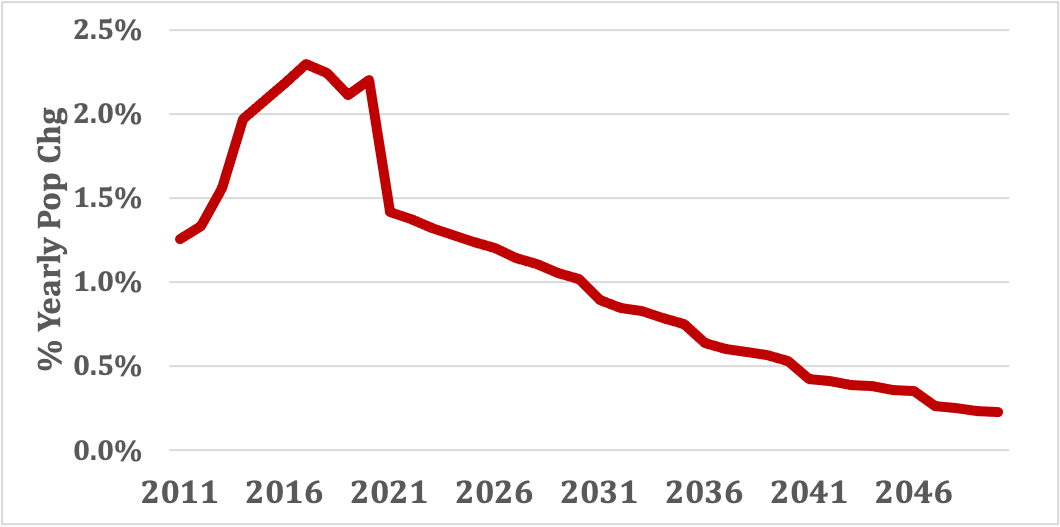The Consortium's sharp drop in Sussex County's population growth in 2021 is questionable, but the long-run trend is undeniable. The Baby Boomers generation of 60+million has precisely hit the midpoint of turning 65 years old in 2021. About 10,000 people a day from this generation are hitting 65. That will continue for another ten years, then drop rather sharply since the Generation X population (born between 1965-1980) is substantially smaller. Our guess is that the down ramp shown in the above graph will not be as sharp through 2026, but then decline will set in.
A slowdown in the population growth of Sussex County will be a blow to Delaware's economy. Compared to Sussex County's annual population growth of 2.3%, the annual population growth in New Castle County is 0.4%. Over the past decade, total personal income grew 40% in New Castle County and 71% in Sussex County, and per capita income increased 34% and 42%. Income from dividends and interest rose 48% in New Castle County and 80% in Sussex County. Similarly, total employment increased 13% in New Castle County compared to 24% in Sussex County.
Can anything be done to change this future scenario? There might be investments to enlarge highway infrastructure, but there are obstacles in the way.
First, the Delaware Population Consortium projections are the official numbers issued by Delaware State Planning Office and thus are investment guidelines for DelDOT and other agencies. DelDOT, for example, would look at the current projection and see little urgency for immediate highway projects in Sussex County.
Second, there have been various political roadblocks to expanding Sussex County's infrastructure. In the 70's when Republicans were governors, offers were made to fund expansion of east-west highways in Sussex County like routes 16, 24, and 26 (that's the route to the beaches from metro DC and west Baltimore) but were rebuffed by some large farmers/landowners/ politicians from Sussex County that wanted to keep their rural ways.
Then, for 30 years with Democrats in the Governor's mansion, the infrastructure dollars were nearly all spent in New Castle County in the billions spent on I-95 Christiana Mall and I-95 Astra Zeneca 202 interchanges, Middletown connector from the C&D Canal, new Bridge to Route 13 and all the highway work in and around Newark. The money goes where the votes are, and New Castle County had the votes and still does.
Finally, about ten years ago, Sussex County Government gave over complete control of all county roads to the state in exchange for promises of expansion and modernization. It didn't happen. There were lots of planning and public meetings but no construction. That said, over $1.3 billion of desperately needed highway and road projects are in the DelDOT budget for Sussex projects and have started in earnest this year.
There may be some investments in Sussex County's highway infrastructure, but not with speed or at the magnitude required to prevent rising road congestion from curbing the residential demand around the beaches and inland bays. The more than 7,000 already approved residential building permits currently in the pipeline mean the congestion will get worse.
What will be the impact on the Sussex County residential construction industry? Overtime spending will continue on the renovation and remodeling of existing housing. According to the Harvard Joint Center for Housing Studies, approximately 55% of residential construction spending each year comes from renovation and repairs of existing homes, including everything from new plumbing, roof replacement, and home modifications to accommodate aging owners. Construction spending on new housing is what is threatened by increasingly congested roadways.

